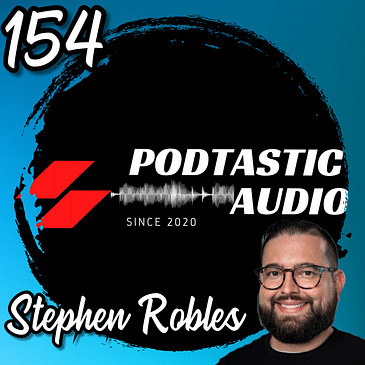In this episode of Podtastic Audio, I dive deep into the realm of video podcasting, offering invaluable tips for those of you who are currently audio-only podcasters and are considering adding a visual element to your shows. I introduce Riverside, a cutting-edge tool designed for seamless video and audio recording, editing, and production. To shed more light on the platform's capabilities, I'm joined by special guest Stephen Robles, the face of Riverside. Stephen elaborates on Riverside's impressive features, such as AI-enhanced audio, script-based editing, and the ability to handle all production elements, making it a game-changer for content creators.
We also discuss the significance of YouTube for podcast discoverability, emphasizing the power of short-form content like YouTube Shorts, Instagram Reels, and TikToks for reaching new audiences. Stephen shares his expertise on creating engaging video content, including the use of multiple camera angles and screen recordings to maintain viewer interest. We also touch on the potential of Apple's Vision Pro, exploring its immersive experiences and future applications.
This episode is packed with practical advice and insights, making it a must-listen for any podcaster looking to elevate their content with video. Whether you're a seasoned podcaster or just starting out, Stephen and I provide the tools and knowledge you need to make your podcast truly spectacular. Tune in to discover how you can leverage video to enhance your podcast and reach a wider audience.
00:00:00: Introduction and Welcome
00:04:00: Introduction of Guest - Stephen Robles
00:05:27: Stephen's Journey with Riverside FM
00:07:36: Importance of Subscriber Count vs. View Count on YouTube
00:09:17: Retention Rate and Content Length on YouTube
00:12:53: Creating Effective Hooks for Podcasts and Videos
00:16:20: The Role of YouTube Shorts in Discovery
00:18:57: Growing Subscribers with Short Form Content
00:20:29: Using Riverside for Video Podcasts
00:25:55: Importance of Video for Podcasters
00:27:13: Using iPhone Camera for High-Quality Video
00:30:16: Managing Notifications While Recording
00:32:15: Editing and Multicam Clips
00:33:54: Planning for Minimal Editing
00:34:20: Editing Software and Tools
00:36:32: Riverside Pricing Plans Breakdown
00:38:19: Media Board and Live Clip Integration
00:39:25: Minimum Requirements for Running Riverside
00:42:21: Discovering Riverside's Media Section
00:43:55: Discussion on Apple Vision Pro
00:45:15: Potential for Cheaper Apple Vision Models
00:46:48: Use Cases for Apple Vision Pro
00:48:44: Comparison with Oculus and 360 Cameras
00:50:00: Future of Immersive Content
00:51:06: Closing Remarks and Where to Find Stephen Robles
Thanks so much for listening, I really appreciate it so much. Sign up for my newsletter so you never miss a moment. Podtastic Audio Newsletter
